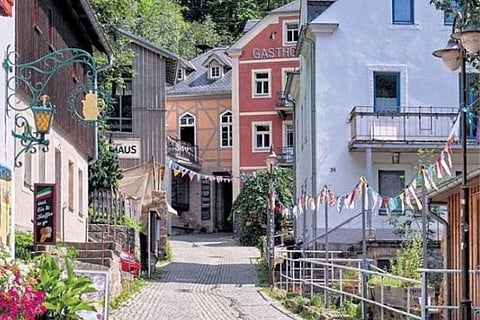
- LIFESTYLE
- FASHION
- FOOD
- ENTERTAINMENT
- EVENTS
- CULTURE
- VIDEOS
- WEB STORIES
- GALLERIES
- GADGETS
- CAR & BIKE
- SOCIETY
- TRAVEL
- NORTH EAST
- INDULGE CONNECT

Step off the ferry at Schmilka and follow your nose. The toasty sweet aroma of baking bread mingles with that of fresh flour being milled across the cobbled street. The mill is a faithful recreation of the original 17th-century one that stood on the very spot and is powered only by water from a nearby creek. Schmilka—located in the district of Bad Schandau in Germany’s Saxon Switzerland region—was a popular holiday village in the 17th and 18th centuries.
“Artists such as Canaletto and Caspar David Friedrich came here to paint. In fact, it was a work by late German artist Adrian Ludwig Richter that helped us reconstruct the mill in a historically accurate manner,” says local guide and historian Andrea Bigge. A plaque nearby exhibits a copy of the painting—present-day Schmilka looks much like it did in the 1800s. That was not always the case, though.
Flashback to 30 years ago, when Schmilka was in ruins like many rural areas of erstwhile East Germany—a mere collection of abandoned, dilapidated houses and a handful of residents. Its location on the bank of Elbe River—just an hour from Dresden—attracted the attention of entrepreneur and hotelier Sven-Erik Hitzer. In 1993, he took over one of the houses to convert it into a boutique hotel. Over the next three decades, he restored more houses and also encouraged local businesses to restart.
Today, this tiny village of about 50 people (plus another 50 hospitality employees) has about 150 beds across colourful half-timbered houses. Schmilka is based on the Italian concept of albergodiffuso, where guest rooms are spread out in various buildings within a small town or community. The restoration of the hamlet is meticulous. “Buildings can be painted only with organic colours found in nature like yellow, green and red. Also, any new construction should be recognisable; it shouldn’t masquerade as old,” elaborates Bigge.
Sustainability may be a buzzword today, but it’s a principle that guided Hitzer. Bread, beer and food at all restaurants are made using locally-grown organic produce. The village is powered by solar energy and waste heat; the hotels have sustainable furnishing; and most of the hospitality employees are provided accommodation in the village to reduce driving. Schmilka itself is a car-free village.
The village’s isolated location in the forested hinterlands combined with easy access from Dresden makes it an ideal day trip. It abuts Saxon Switzerland National Park, so there are plenty of hiking opportunities, including to the famous Bastei sandstone rock formation nearby. There is also a wellness retreat in Saxony, offering everything from forest bathing and yoga to massages and sauna. In winter, Schmilka turns into a fairy tale village, complete with twinkling lights, campfires, mulled wine, and even a hot beer tub.
In 2012, the old village bakery, which uses a vintage wood-fired oven, was resurrected as Schmilkaer Mühle. Organic spelt that’s grown in and around the village is ground in the restored water-powered mill and used for baking. It is famous for its sweet and savoury pies, the size of wagon wheels. These delicacies are made with seasonal vegetables, fruits, berries, nuts and quark (cream cheese).
The Schmilkaer Brauhaus (brewery) next door opened in 2015 in the same building as the original one. Here, master brewer Uli Klimmer produces unfiltered and unpasteurised beer using natural fermentation techniques, just like 300 years ago—it is even bottled by hand. Both the bakery and brewery can be visited on a guided tour, followed by a tasting. So if you are in the mood for some time travel, pay the quaint village of Schmilka a visit.